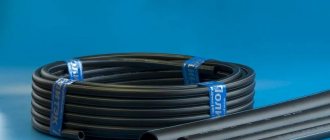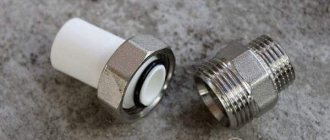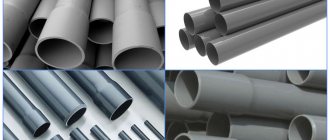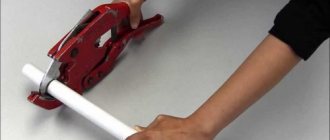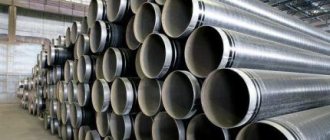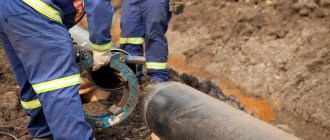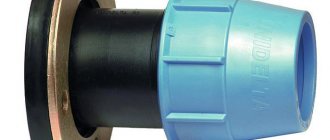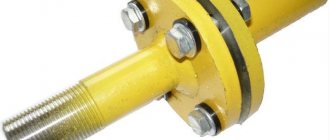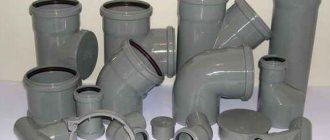What are HDPE pipes?
HDPE is produced by extrusion from polymerized ethylene. Finished products in the form of pipes are used for the construction of highways for the transportation of liquid and gaseous media. This can be natural fuel, drinking or industrial water, wastewater. The classification is also based on the permissible pressure inside the channels. High-pressure ones cope with 2.5 MPa, low-pressure ones with 0.6 MPa, non-pressure ones are designed for the installation of gravity wires.
The basic technical characteristics of HDPE pipes are as follows:
- the operating temperature range is presented as -20-+40 degrees Celsius;
- the maximum thermometer readings are +70 degrees Celsius;
- strength up to 38 MPa;
- pressure ranging from 6 to 25 Atm;
- diameter up to 120, less often up to 150 mm.
In addition to the construction of highways using HDPE products, protection devices for electrical wiring are allowed. The product lasts for about 50 years. On trading floors, pipes are presented in the form of coils of 100, 200 and 1000 m or sections of up to 12 m.
Coils and cut products from HDPE Source billionnews.ru
Advantages and operational features of HDPE pipes
The versatility regarding the use of HDPE pipes is explained by the tightness, elasticity and resistance of the material to aggressive operating conditions. The internal surface of the products is smooth, which virtually eliminates the risk of accumulation of sludge and deposits, ensuring efficient use of the wire throughout its entire service life.
Also, the advantages of such products include the following properties:
- corrosion resistance;
- inertness to the chemical environment;
- lightness (almost 6 times less than steel);
- plasticity (movement without depressurization is allowed by 5-7% of the initial position, which is important in case of freezing of transported liquids);
- resistance to water hammer;
- simplicity regarding installation and maintenance;
- low cost.
HDPE wire for drinking water Source otoplenin.ru
The material is environmentally friendly and allows for self-installation. But there are disadvantages that need to be considered before choosing. It is unacceptable to use HDPE pipes for heating equipment. To lay channels in the ground, its mobility must be taken into account. Ultraviolet radiation negatively affects the technical characteristics of the material.
Determination of Applicability
To simplify the selection of low-density polyethylene pipes, manufacturers mark the finished product and apply a color indicator. Thus, a yellow longitudinal stripe indicates the purpose for a gas pipeline, red and blue - for cold and hot water, respectively. Regarding the maximum pressure, the designations PE 63, PE 80 and PE 100 are applied. Underneath this lies 6.3, 8 and 10 MPa.
Marking on finished products Source dpm-system.ru
Another method (also indicated in the labeling) involves tracking the SDR indicator. This is a dimensional coefficient that hides the ratio of the cross-section to the wall thickness. It looks like this (SDR/pressure limit):
- For pressure main systems, gas pipelines and sewers, the following indicators are relevant: 6/25, 7.4/20, 9/16, 11/12.
- Irrigation installations and low-pressure water pipelines: 13.6/10, 17/8, 17.6/7.
- Water supply to low-rise buildings is provided by pipes with SDR 21 and a permissible pressure of 6 Atm.
For internal service of houses with drinking water and gravity sewerage systems, products with a size coefficient of 26, 33 or 41 are used. This corresponds to a pressure of 4 to 5 Atmospheres.
Equal tee
Polyethylene equal-bore tees are used in PE100 and PE80 pipelines when transporting water and gas.
| ||||||
| d | Weight, kg | e | L | z1 | Z | |
| 20 | 0.035 | 1.9 | 41 | 64 | 108 | |
| 25 | 0.035 | 2.3 | 41 | 73 | 122 | |
| 40 | 0.120 | 3.7 | 52 | 102 | 162 | |
| 50 | 0.202 | 4.6 | 57 | 117 | 184 | |
| 63 | 0,375 | 5,8 | 63 | 150 | 230 | |
| 75 | 0,615 | 6,8 | 70 | 160 | 246 | |
| 90 | 1,210 | 8,2 | 75 | 184 | 280 | |
| 110 | 1,580 | 10,0 | 82 | 222 | 330 | |
| 125 | 2,240 | 11,4 | 97 | 239 | 347 | |
| 140 | 3,200 | 12,7 | 104 | 270 | 390 | |
| 160 | 4,270 | 14,6 | 98 | 304 | 440 | |
| 180 | 7,090 | 16,4 | 140 | 350 | 525 | |
| 200 | 8,260 | 18,2 | 124 | 353 | 500 | |
| 225 | 9,200 | 20,5 | 120 | 390 | 540 | |
| 250 | 14,840 | 22,7 | 130 | 416 | 575 | |
| 280 | 18,670 | 25,4 | 133 | 452 | 615 | |
| 315 | 22,000 | 28,6 | 145 | 524 | 712 | |
| 355 | 39,800 | 32,2 | 167 | 592 | 820 | |
| 400 | 42,450 | 36,3 | 198 | 657 | 910 | |
| 450 | 77,300 | 40,9 | 195 | 711 | 970 | |
| 500 | 101,000 | 45,4 | 215 | 780 | 1060 | |
Connection methods
How to connect HDPE pipes to each other - the answer is technology. Homogeneous pipes can be connected using fittings or a welding device. In both cases, the tightness is maintained, although in the case of additional parts, the result largely depends on the quality of the products and compliance with installation rules.
Welded joint
For permanent connection of polyethylene pipes, special equipment is required. The weld seam forms a continuous seam, but the device is expensive, which ultimately affects the cost of construction and repair of communications. It is also worth noting that it is impossible to reconnect in case of an error.
Weld on a highway Source www.gnb-teh.ru
This kind of installation is carried out in 2 ways: joint to joint or using an electric coupling. In the first case, the ends of the pipes are subject to melting. The second option involves the use of a polyethylene part with a built-in metal spiral. The latter is heated using electric current, which promotes the formation of a weld.
Detachable connection
A detachable connection implies the possibility of dismantling and reconnecting pipes without violating the integrity of the pipes or disassembling the entire pipeline. For the installation of HDPE pipes, special sealed fittings are used, which can be used repeatedly. The advantage of this method is that there is no need for special equipment and inexpensive couplings.
Bushing short
Short flange sleeve (short flange collar) is used to connect a pipeline to shut-off valves or to obtain a detachable flange connection. The bushings are equipped with steel flanges, the inner part of which is bored to a certain diameter. The difference from the polyethylene extended bushing is the absence of an extended part of the shank, which is necessary for gripping the butt welding machine with clamps. Therefore, during welding, the short sleeve is fixed using a special washer, or pre-lengthened in a workshop setting.
| ||||||||
| d | Weight, kg | S | D | D1 | L | H | Z | |
| 315 | 2,810 | 18,7 | 370 | 335 | 29 | 35 | 100 | |
| 355 | 3,900 | 21,1 | 430 | 373 | 50 | 30 | 120 | |
| 400 | 6,060 | 23,7 | 482 | 427 | 29 | 50 | 115 | |
| 450 | 10,100 | 26,7 | 585 | 514 | 14 | 46 | 120 | |
| 500 | 9,190 | 29,7 | 585 | 530 | 32 | 60 | 115 | |
| 560 | 13,300 | 33,2 | 685 | 615 | 10 | 50 | 120 | |
| 630 | 10,980 | 37,4 | 685 | 642 | 32 | 60 | 115 | |
| 710 | 18,740 | 42,1 | 806 | 766 | 40 | 60 | 135 | |
| 800 | 26,130 | 47,4 | 910 | 864 | 40 | 60 | 135 | |
| 900 | 33,690 | 53,3 | 1010 | 964 | 40 | 60 | 135 | |
| 1000 | 43,720 | 59,3 | 1118 | 1068 | 40 | 60 | 145 | |
| 1200 | 69,970 | 71,1 | 1336 | 1278 | 40 | 70 | 145 | |
Video description
The video shows how to assemble a HDPE fitting:
See also: Catalog of companies that specialize in engineering systems
This method is recommended for installing channels that are not subject to high pressure. Connections can also be realized in two ways: Compression fittings are sufficiently firmly secured. A socket assembly is rarely installed, as it has a relatively weak seal. Installation involves inserting one pipe into another and placing a sealing rubber gasket between them.
Socket connection of pipes Source www.kozansutesisatcisi.com
Fitting
Depending on the design, fittings can be used as connecting parts in a straight section, branched and rotary. Adapter options regarding pipe diameters and dissimilar materials are also considered. A separate type are plugs.
Connecting HDPE pipes with fittings is carried out in 4 steps:
- choosing a coupling in accordance with the diameter and depth of immersion of the pipe into it;
- ensuring maximum glide using a soap solution;
- unscrewing the nut and inserting the pipe to the desired limit.
The final step is to fix the products. To do this, tighten the clamping nut all the way. The level of tightness of the node connection depends on the degree of tightening.
Fittings for pipeline installation Source the-master.ru
Advantages and disadvantages
Connecting parts for HDPE pipes have the same advantages that are inherent in all polymer products:
- Light weight.
- Wide range.
- Relatively low price.
- Easy to use and install.
- Antibacterial effect.
- Resistance to aggressive chemicals.
- Dielectric properties.
- Absolute corrosion resistance.
- Good elasticity, due to which the fittings are not affected by water hammer.
- Low thermal conductivity.
- Wear resistance.
- Smooth inner surface that offers little resistance to flow.
- High strength.
- Frost resistance. In case of freezing, polyethylene does not deform or crack.
- Excellent sealing of joints.
- Long service life - from 50 years.
The disadvantages of such products include:
- Vulnerability to ultraviolet radiation.
- Low melting point of plastic.
Advice from experienced specialists
The ellipticity of the material can negatively affect the tightness. In this case, the seams will be of poor quality. If the contact is made by welding, then it is important to monitor the immobility of the pipes until the materials completely harden.
Equipment for welding seam Source i.ytimg.com
The ends of the products to be joined must be prepared in advance. This means removing dirt and dust. Additionally, you need to treat the surface with a degreaser.
If fittings with clamping nuts are used, it is important to tighten them to the limit, but not significantly. Excessive force may cause the element to burst. And the collet in this case is capable of crushing the end part of the pipe.
When can butt welding be used?
The method under consideration is usually used in cases where the wall thickness exceeds 5 mm. Preparation of material for the start of work is organized within the framework of the following scheme:
- Align the end of the product relative to the axis of the pipe;
- Remove the chamfer using a sharp knife or (this option is more preferable) a special unit - a chamfer remover;
- Total cleaning and degreasing of the end sections.
It is also necessary to ensure that the main and auxiliary areas that will be in contact with each other are aligned with each other. In simple terms, coaxiality involves installing one part into another in such a way that the pipe in the pipe fits tightly and fits 3/4 of the depth of the coupling, these are the requirements of the technology;
After this (if we are talking about a welding joint), put both soldered parts on the “iron”, let it heat up for the time specified in the instructions for the device and connect, checking the tightness after cooling.
